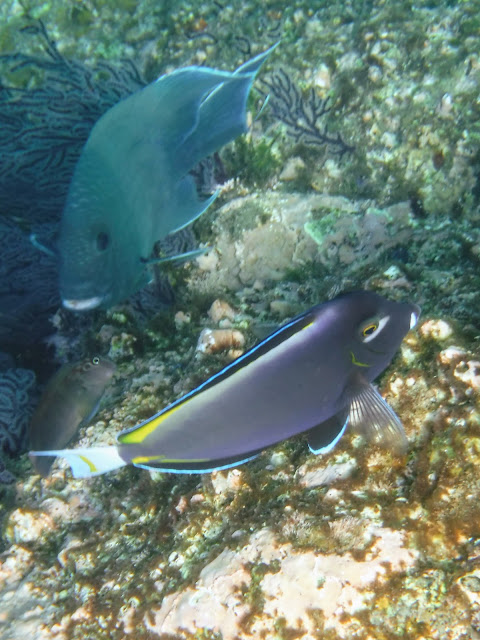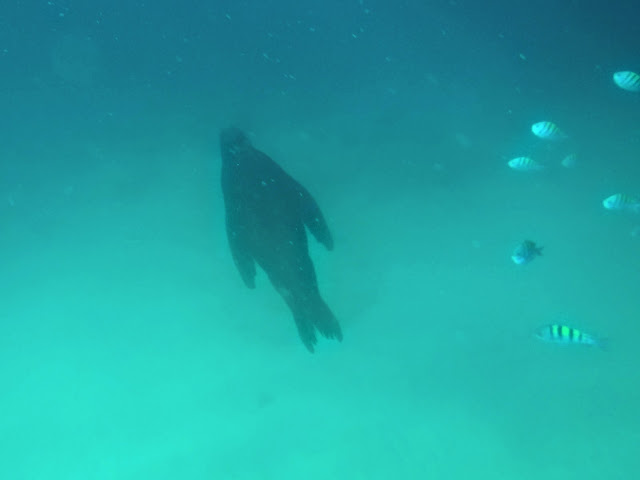I knew I'd return and, finally, thirteen months later I did. But on my recent visit to Pelican Rock in Cabo San Lucas, I left the diving equipment behind and only brought a mask, snorkel, and fins. It had turned out I didn't like diving when I tried it on my previous visit; the bubbles, ear pressure, and hand signals flustered me. Exploring unencumbered by weights and equipment at the water's surface was a much better fit for me. And besides, for me, there were just as many discoveries close to sea level as at thirty feet below.
Cabo has many places to snorkel, mostly all of them on the Sea of Cortez side of the Baja California Peninsula. On stops off of multiple cruises, I've booked various excursions by catamaran and zodiac to Chileno Bay and Santa Maria Cove. Sea life abounds and coral reefs thrive just a short swim off of these beautiful beaches. You can even drive up the scenic Federal Highway 1 and park at an adjacent resort on either of the playas. But why take a forty-five minute boat ride or a half-hour road trip to your snorkeling site when one is waiting less than five minutes from Cabo's busy port?
So after disembarking my cruise ship's tender at the main dock, I easily hired a water taxi that provided snorkeling equipment and a round trip boat ride to Pelican Rock, all for forty dollars. Everyone that visits Cabo San Lucas actually passes this rock formation whether they note it or not; it's on the way to El Arco, a much more distinctive landmark that everyone photographs near the tip of the cape. In fact, this cluster of rocks is the extreme southern end of the entire Baja California Peninsula. To the west lies the open Pacific Ocean while to the east is the much more placid Sea of Cortez.
After a few short minutes, Eduardo, the captain of the Maria Bonita, dropped me off on Pelican Beach, a short, narrow stretch of sand shadowed by high cliffs. He then motored on, leading a sightseeing tour to El Arco with four other passengers. I had arranged for Eduardo to pick me up for the return to the dock, a las tres, in only two hours.
A concession was actually renting masks and snorkels right on the beach so it's possible to negotiate only the water taxi to the location. You can even travel one way and haggle with any of the numerous other boats making stops when you feel like you've had enough fun in the sun and sea.
Many of these transports are glass bottom vessels, outfitted with plexiglass windows along their keels to provide a view of the fish below from a dry bench along each side of the boat. Of course, I planned to don my mask, snorkel, and fins and get wet while exploring from the beach. Lowering my head in the warm water, I was reminded of my last visit, when I called the site a nursery for juvenile fish. Once again, schools of tiny yellowtail surgeonfish crowded my view in the shallow water. Meanwhile, a distant clarion angelfish's loud orange color beckoned me further offshore.
Pelican Rock lay about a hundred yards off the beach, an easy swim with fins. Ropes with floats protected the area from speeding boat traffic and anyone that jumps from the sea side of the steep monolith. Below water, the rock is a sheer wall, covered in coral, sea urchins, and sea fans, descending over twenty feet to the sea bottom.
King angelfish abounded, flashing their yellow fins against their navy blue bodies. Giant damselfish along with their scintillating juvenile offspring hugged the outcrop. Guineafowl puffers, some polka-dotted, others a canary yellow, a form I'd never seen before, scavenged mostly in pairs. A couple of white-cheeked surgeonfish were colorful finds, as was an especially large and photogenic redlip parrotfish. I saw at least two varieties of triggerfish, an orangeside and a mottled one I've yet to identify.
Two brand-new encounters were easy to name while a third utterly terrified me. The first was a panamic green moray eel, seemingly quite large as it tried to hide in a shadowy crevice of Pelican Rock. The second was a barberfish, or black-nosed butterflyfish. To the best of my recollection, these new creatures were also the first eels and butterflyfishes of any kind I've ever encountered in Cabo San Lucas.
The third meet-up was with a sea lion. While hundreds of the species congregate along the local piers and beg for hand-outs from all the fishing boats returning to port, one has never swum near me while I was in the water. However, that's exactly what one did while I was snorkeling near Pelican Rock, swimming from behind me, several feet below, scaring the bejesus out of me when I saw the dark form suddenly appear in my field of vision. Since the pinniped was swimming away, I quickly gained my composure and managed to get a single photograph.
I thought back to the day before on my cruise ship, when I attended a lecture on great white sharks. Sharks are ambush predators, relying on the element of surprise in their hunts, so it's no wonder my initial surprise was a moment of terror.
No doubt about it, Pelican Rock has a lot to offer both the experienced and the beginner snorkeler. Smaller rocky outcrops closer to the beach shelter even more sea life. In addition, the location is easy to reach from the piers of Cabo's crowded port, adjacent to one of the most photographed scenes on the west coast of Mexico. A variety of marine life thrives in the shallow waters and avian life like frigatebirds, ospreys, and yes, pelicans fills the sky.
I don't know if Pelican Rock is the best snorkeling spot in Cabo San Lucas, but it's certainly as good as any place I've yet to see in Baja.
 |
| View of Pelican Rock in Cabo San Lucas from Pelican Beach. |
 |
| Clarion angelfish. |
 |
| Guineafowl puffer, yellow form. |
 |
| Giant damselfish and white-cheeked surgeonfish. |
 |
| Sea lion swimming below me near Pelican Rock in Cabo San Lucas. |
 |
| Guineafowl puffers. |
 |
| Barberfish aka blacknosed butterflyfish. |
 |
| Yellowtail surgeonfish. |
 |
| King angelfish. |
 |
| Redlip parrotfish among other fish at Pelican Rock in Cabo San Lucas. |
 |
| Panamic green moray eel. |
Comments
Post a Comment